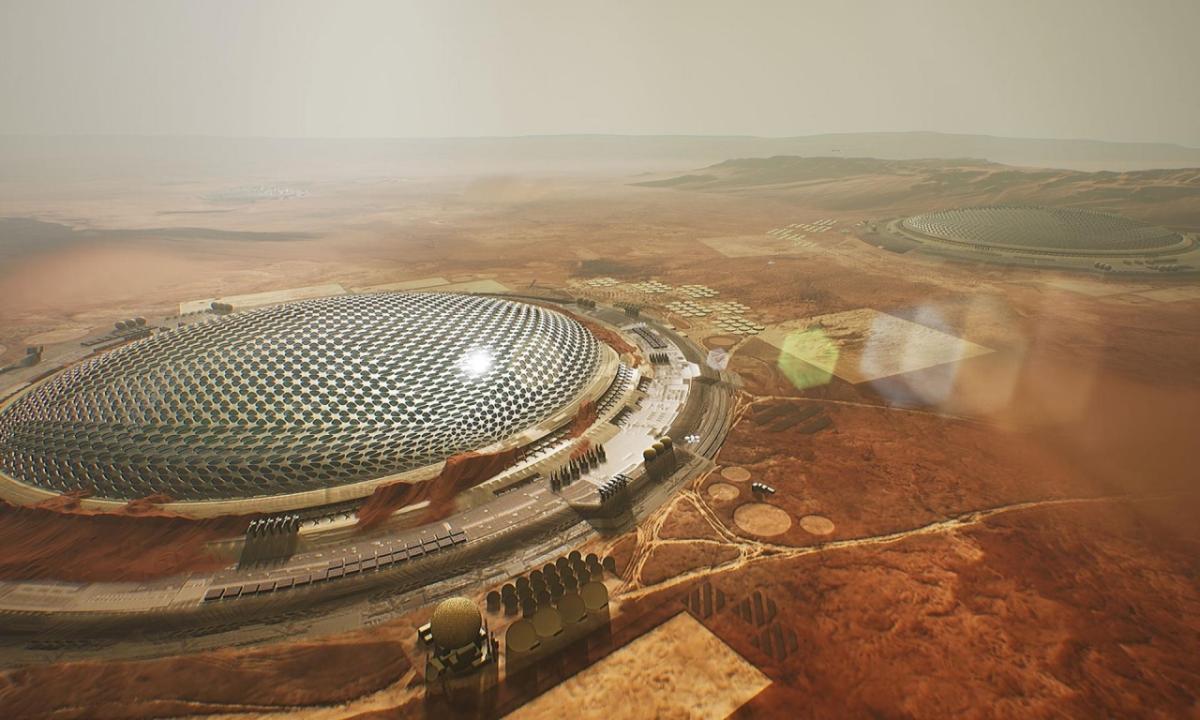What Does a City of One Million People on Mars Look Like?
The winners of the final HP Mars Home Planet challenge create utopian visions of the Red Planet.

An urban utopia on Mars might be closer than you think.
For the past year, creative professionals, students, space geeks—even families—have been creating their visions for a metropolis on the fourth planet from the sun. The final winners of the HP Mars Home Planet challenge were announced by HP and unveiled in a VR experience at SIGGRAPH 2018, an annual computer graphics convention, in Vancouver.
“The amazing entries from the HP Mars Home Planet challenge give us a virtual window into what life on Mars could be like for a million members of humanity,” says judge Dr. Darlene Lim, a geobiologist and principal investigator, NASA Biologic Analog Science. “Technological advancement is being met by a broad array of foundational space science and planetary research—a confluence that will optimistically serve to accelerate our path toward human exploration and settlement of Mars.”
The red planet re-imaginedFreezing cold and with an atmosphere 100 times thinner than Earth’s, Mars is a hostile environment for life as we know it. How do you protect people and plants from lethal radiation rays or vicious sand storms? What kind of transport can move people and supplies around in Mars’ weak gravity? How will energy be created — not to mention enough oxygen to sustain humans? What will be done with waste? Imaginative and clever enthusiasts from Earth rolled up their sleeves and committed months of personal time to their ideas on how humans could flourish on the Red Planet.
The year-long competition exceeded expectations and inspired more than 87,000 creative pros, students, scientists and space fans from over 150 countries to imagine how life would work for an established colony of one million people. The public challenge was made up of three competitions: Concept, 3D Modeling and Rendering. (Read about the previous two rounds here and here.)
All the submissions had to consider the physical constraints of the alien environment. In the concept phase of the contest, close to 500 entries were evaluated for potential to sustain a meaningful life for a million humans. For the 3D modeling phase, a new set of teams and individuals submitted more than 330 designs and 3D models. All participants used 40 square km of actual Mars terrain developed by Fusion for its Mars 2030 game, based on NASA research and high-resolution photograph.
In the final phase, a fresh group of visionaries and explorers-at-heart created renderings of what life in Mawrth Vallis (Mars Valley)—a NASA-identified landing site—could look and feel like for one million inhabitants. Nearly 180 still, animated, real-time or VR renderings addressed two main categories: architecture/civil engineering and vehicles/mechanical engineering.
An out-of-this-world effortThe results were thoughtful, imaginative and inspiring. In the nearly 38-km diameter Louth Crater, a massive clear glass dome soars over a thriving city. Inside, expandable cloth billows, maintaining comfortable oxygen and temperature levels while filtering solar radiation. Another dome houses flora and fauna for food and research, as well as species of wildlife, allowing Martian citizens to get away from it all with a hike or a weekend camping trip. Towering vertical axis generator turbines harness the power of even the strongest windstorm, and the mirrored petals of a giant solar concentrator bloom to capture solar radiation. Personal utility vehicles are equipped with huge tires, like motorcycles on steroids, to provide rapid transportation over the harsh terrain.
"The entries were amazingly detailed and well-conceived,” says judge Chris DeFaria, President of Dreamworks Animation Group. “I was particularly taken with the VR renders and imagine this will be a valuable tool as we plan for an exciting future.”
Participants had access to the work of the finalists from the modeling challenge, who provided their CAD files for use by these new teams. The entries were evaluated by a panel of judges representing a broad spectrum of fields, including John Spencer, EVP and chief designer, Mars World Enterprises; Carla Swickerath, CEO of Studio Libeskind; and Dr. Sanjay Vijendran of the Mars Mission for the European Space Agency.
Sharing the virtual dreamOn August 14, a VR experience made up of the winning entries created by Epic Games’ Unreal Engine was unveiled at SIGGRAPH 2018. Sitting in motion-enabled Positron Voyager chairs and wearing HP Windows Mixed Reality headsets, visitors got to explore the Martian city as the challenge participants envisioned it, moving through a Martian Community Onboarding Center and moving through the inspiring architectural, engineering and transportation designs that could enable a sophisticated human metropolis.
Here's a glimpse of what life on Mars could look like.
Learn more about the winning submissions.
Here's a full list of the winners of the HP Mars Home Planet Rendering Challenge
Architecture/Civil Engineering
Still Rendering – GPU Rendered Winner:
Stefan Misirdzhiev
Bulgaria
Still Rendering – CPU Rendered Winner:
Max Rymsha
Ukraine
Animated Rendering – GPU Rendered Winner:
Csaba Molnar
Hungary
Animated Rendering – CPU Rendered Winner:
Wai Kin Lam
UK
VR or Real-Time Executable Winner:
Roberto De Rose
Italy
Vehicles/Mechanical Engineering
Still Rendering – GPU Rendered Winner:
Aidan Ryan
USA
Still Rendering – CPU Rendered Winner:
Kodikara Perera
Canada
Animated Rendering – CPU Rendered Winner:
Martian Power Generating Machines
Bijay Balia Hembram
India
VR or Real-Time Executable Winner:
Martian Hybrid Power Plant VR Experience
Bijay Balia Hembram
India

